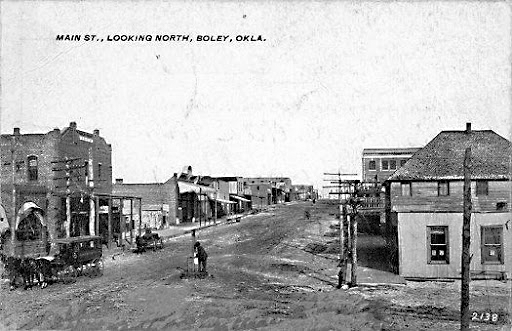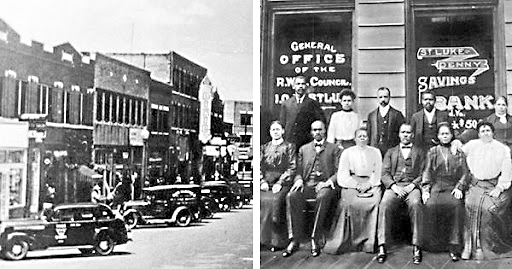

The infamous Tulsa Race Riot destroyed one of the most successful black towns in the U.S.
The All-Black towns of Oklahoma represent a unique chapter in American history. Nowhere else, neither in the Deep South nor in the Far West, did so many African American men and women come together to create, occupy, and govern their own communities. From 1865 to 1920 African Americans created more than fifty identifiable towns and settlements, some of short duration and some still existing at the beginning of the twenty-first century.
All-Black towns grew in Indian Territory after the Civil War when the former slaves of the Five Tribes settled together for mutual protection and economic security. When the United States government forced American Indians to accept individual land allotments, most Indian “freedmen” chose land next to other African Americans. They created cohesive, prosperous farming communities that could support businesses, schools, and churches, eventually forming towns. Entrepreneurs in these communities started every imaginable kind of business, including newspapers, and advertised throughout the South for settlers. Many African Americans migrated to Oklahoma, considering it a kind of “promised land.”
When the Land Run of 1889 opened yet more “free” land to non-Indian settlement, African Americans from the Old South rushed to newly created Oklahoma. E. P. McCabe, a former state auditor of Kansas, helped found Langston and encouraged African Americans to settle in that All-Black town. To further his cause, McCabe established the Langston City Herald and circulated it, often by means of traveling agents, throughout the South. McCabe hoped that his tactics would create an African American political power block in Oklahoma Territory. Other African American leaders had a vision of an All-Black state. Although this dream was never realized, many All-Black communities sprouted and flourished in the rich topsoil of the new territory and, after 1907, the new state.
In those towns African Americans lived free from the prejudices and brutality found in other racially mixed communities of the Midwest and the South. African Americans in Oklahoma and Indian Territories would create their own communities for many reasons. Escape from discrimination and abuse would be a driving factor. All-Black settlements offered the advantage of being able to depend on neighbors for financial assistance and of having open markets for crops. Arthur Tolson, a pioneering historian of blacks in Oklahoma, asserts that many African Americans turned to “ideologies of economic advancement, self-help, and racial solidarity.”
Marshalltown, North Fork Colored, Canadian Colored, and Arkansas Colored existed as early as the 1860s in Indian Territory. Other Indian Territory towns that no longer exist include Sanders, Mabelle, Wiley, Homer, Huttonville, Lee, and Rentie. Among the Oklahoma Territory towns no longer in existence are Lincoln, Cimarron City, Bailey, Zion, Emanuel, Udora, and Douglas. Towns that still survive are Boley, Brooksville, Clearview, Grayson, Langston, Lima, Red Bird, Rentiesville, Summit, Taft, Tatums, Tullahassee, and Vernon. The largest and most renowned of these was Boley. Booker T. Washington, nationally prominent African American educator, visited Boley twice and even submitted a positive article on the town to Outlook Magazine in 1908.
The passage of many Jim Crow laws by the Oklahoma Legislature immediately after statehood caused some African Americans to become disillusioned with the infant state. During this time Canada promoted settlement and, although the campaign focused on whites, a large contingent of African Americans relocated to that nation’s western plains, forming colonies at Amber Valley, Alberta, and Maidstone, Saskatchewan. Another exodus from Oklahoma occurred with the “Back to Africa” movements of the early twentieth century. A large group of Oklahomans joined the ill-fated Chief Sam expedition to Africa. A number of other African Americans migrated to colonies in Mexico.
White distrust also limited the growth of these All-Black towns. As early as 1911 whites in Okfuskee County attempted to block further immigration and to force African Americans into mixed but racially segregated community’s incapable of self-support. Several of these white farmers signed oaths pledging to “never rent, lease, or sell land in Okfuskee County to any person of Negro blood, or agent of theirs; unless the land be located more than one mile from a white or Indian resident.” To further stem the black migration to eastern Oklahoma a similar oath was developed to prevent the hiring of “Negro labor.”
Events of the 1920s and 1930s spelled the end for most black communities. The All-Black towns in Oklahoma were, for the most part, small agricultural centers that gave nearby African American farmers a market. Prosperity generally depended on cotton and other crops. The Great Depression devastated these towns, forcing residents to go west and north in search of jobs. These flights from Oklahoma caused a huge population decrease in black towns.
As people left, the tax base withered, putting the towns in financial jeopardy. In the 1930s many railroads failed, isolating small towns in Oklahoma from regional and national markets. As a result, many of the black towns could not survive. During lean years whites would not extend credit to African Americans, creating an almost impossible situation for black farmers and businessmen to overcome. Even one of the most successful towns, Boley, declared bankruptcy in 1939. Today, only thirteen historical All-Black towns still survive, but their legacy of economic and political freedom is well remembered. A fourteenth town, IXL, is new, incorporated in 2001

